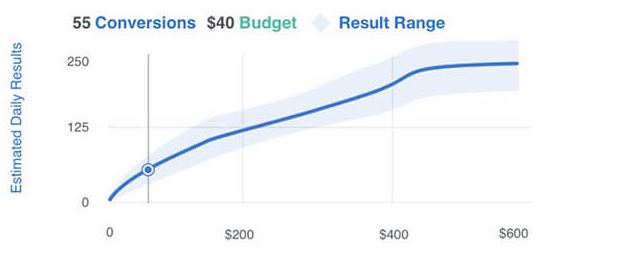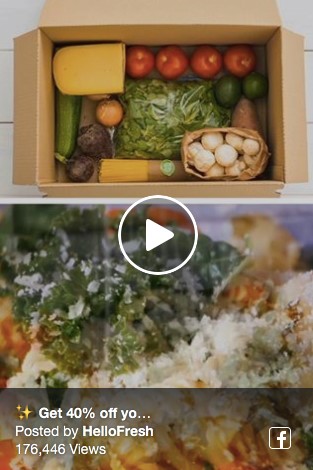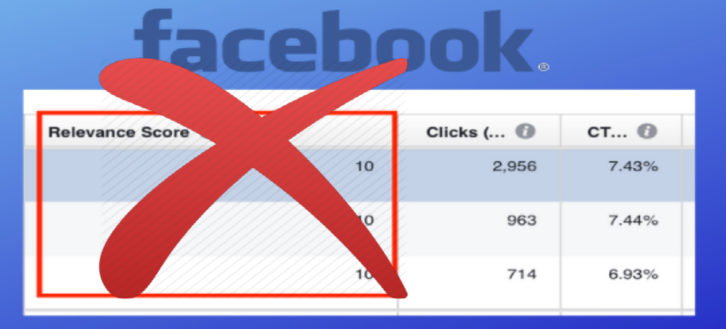Didn’t like Facebook’s Relevance Score? No drama – it’s now gone. Ended. Finito.
Just like Google, Facebook is always tweaking its metrics and algorithms so that marketers have to stay on their toes to keep up. And now, in 2019, Facebook has gone and ditched their Relevance score.
They’ve not just tweaked it – they’ve ditched it altogether.

For many, this is probably a massive relief. After all, the Relevance score was confusing. It left numerous marketers scratching their heads if their relevance score was low because there wasn’t much advice on what they could do to raise it. And even if it was high, no one really knew how much importance they should attach to it.
But the big question now is – what’s next?
In this article, we take a look at the brand new Facebook ad quality metrics you need to get your head around.
What Was The Relevance Score and Why Has It Gone?
If you pop into your Facebook Ads Manager account, you will see a message at the top that looks like this:

So, the old metrics are out and new ones are coming. How come?
In a nutshell, the Relevance score was meant to tell you how engaging and relevant your ad is so that you could generate better leads. Put it this way: If your ad wasn’t really relevant to the audience you are targeting, you’d get penalized with a low Relevance score.
And we say “penalized” because you got slapped with a premium – which meant paying more for clicks – just for having the nerve to serve an irrelevant ad to people.
On the other hand, if your ad was more refined and thus more relevant to the audience you are targeting, Facebook would charge you less. Yay.

The problem for everyone was that the Relevance score was based on expected performance as opposed to actual performance. This intuitive nature meant that a lot of marketers were left confused.
And – as mentioned – they weren’t sure how to make their ads more relevant if they got hit with a low score. Let’s say their ad had a relevance score of 4. Well, so what? Facebook didn’t tell them how to improve things going forward.
In short, the Relevance score was bad and that’s largely the reason it’s gone. Yay.
But before we move on, it’s not the only metric that’s gone. Facebook has also closed the book on:
- Offers saved
- Web purchase ROAS
- Mobile app purchase ROAS
- Messaging replies
- Cost per offers saved
- Cost per messaging replies
Great. So What Are These New Ad Quality Metrics?
Facebook wants you to create awesome ads that better serve your audience. The last thing they want is for their own users to be bombarded with ads that have zero relevance to them and their lifestyles. Because that might even cause them to quit Facebook altogether!
And, you know, that’s really another reason they’ve rolled out these new metrics. There are 3 new ad quality metrics:

Quality Ranking
This metric compares your ad quality with other ads that are targeting the same audience.
Engagement Rate Ranking
This metric pits your expected engagement rate against the expected engagement rate of ads that are targeting the same audience.
Conversion Rate Ranking
This metric compares your ad’s anticipated conversion rate with the anticipated conversion rate of a rival ad that’s again targeting the same audience.
All of these metrics aren’t considered during your ad’s auction performance. Instead, they show you how changes to the post-click experience, audience targeting and creative assets can impact the performance of your ads.
This is what Facebook themselves had to say about the changes:

What Are The Benefits Of These New Ad Metrics?
The Relevance score was meant to benefit to marketers. Only, it turned out to be very un-beneficial. So why should we believe Zuckerberg now that his company has rolled out these new metrics?
Well, for one thing, Facebook is rolling these new metrics out to rebuild trust with marketers who splash a LOT of money on ads. The metrics are meant to help you understand how to make your ads better so that your ROI and bottom line increases. Facebook wants to help you help your audience out – which, in turn, will help you and Facebook out (try to keep up). Indeed, Facebook needs to build bridges with businesses, as a period of growth deceleration was alarming. While advertisers aren’t leaving the platform in their droves, they do want more help from Facebook.

The biggest benefit is that the change is reflective of the fact that fewer people are now scrolling through their newsfeed, which means they’re engaging with fewer ads. As such, Facebook wants to make sure that the content they’re engaging with is the right content.
And, well, Facebook has rolled out the chances because marketers and advertisers have been crying out for more accurate estimates so that they know what they’re dealing with. These new metrics should (hopefully) deliver on that front.
Marketers will also have more control over where their ads appear, thanks to the recent unveiling of Facebook’s brand safety certification, while the introduction of the new ad-buying procedures for premium video content should make it easier for brands to produce video content that really hits the spot more often while getting more bang for their buck.
How To Keep Your Ad Content Relevant
It’s early days with the new metrics, but there are evergreen ways you can keep your ads as relevant and useful to your target audience as possible so that your ROI is as high as possible. Here are some tips:
Produce High-Quality Content
Facebook is just like Google in that it wants you to improve the user experience. If you were worsening the user experience – and if your competitors were doing this too – it would reflect very badly on the Facebook brand and fewer people would sign up.
So if your ad is poor quality, it won’t reach many people. Facebook will prevent it from doing so and for a good reason. But how do you keep the quality of your ads high?
- Use visuals – And not just any old visuals. If your budget extends far enough, consider opening up a Shutterstock account so that you can add high quality, eye-catching images to your posts. Stock images are old-school and people don’t buy into them anymore. While we’re here, make sure your image passes Facebook’s Image Text Check tool before you run it

AirAsia created a customized image for their ad and it really stands out
- Optimise for mobile – More and more people are viewing your ads on their mobile devices, so make sure you deliver a high-quality mobile experience
- Keep your copy short and sweet – The shorter (and sweeter) your copy is, so much the better. Be direct with your copy, too. Use short words everyone understands and avoid rambling on about something and nothing. Get to the point
Here are some more tips for enhancing your social media content.
Encourage Interactions
If no one interacts with your ads, that’s a major red flag to Facebook because it tells them that your ad isn’t relevant to its target audience.
Think about it: If people are interacting with your ad – commenting, liking and sharing – it means it’s totally relevant to them and their needs.
The thing is that your ad could be relevant to its target audience, but no one is interacting anyway. Why not? Well, perhaps you haven’t given them enough encouragement.
Sometimes people need a little push. Don’t be afraid of using your copy to encourage people to like, comment or click through. Tell them what it is you want them to do and add a compelling call to action.
The easiest way to get people to engage with your ad? Ask them a question!
Choose The Right Facebook Ad Format
This one can be a tricky one to get right because there are a lot of Facebook ad formats available, and they’re all good for different needs.
But you’ll need to set some time aside to deciding which one is best suited for your campaign objectives before optimising the content because this one act alone can make or break your score for the better.
Use Video Ads
Video ads are great for conversions. Now that Facebook has rolled out the conversion rate ranking metrics, it’s key that you start using more video ads.
Indeed, research has shown how effective video is on social media in general, with folk watching video ads 5x longer than a static post.
Interestingly, though, it’s the 65+ crowd that engages more with video ads. While 18 to 24-year-olds also watch video ads, their attention span is down 75%. Fear not, though. This just means that you need to keep your video ads as short as possible – perhaps 15 seconds or less?
Because 85% of videos on Facebook are watched without sound, it’s a very good idea to add subtitles to yours. Make the text bold and stand-out.

Seeing a “play” button compels people to click
Make Sure You’re Targeting The Right People
This is the crucial bit, isn’t it? You need to target the right audience if your ads are to generate leads.
Facebook gives marketers a few options for this, and you can tweak your audience according to their interests, their connections, their demographics, their location and their behaviour.
Then there is the option of Custom Audiences, which lets you reach existing customers from your mobile app, website and any other list of customers you have.
There’s also the Lookalike Audiences feature that lets you target more people who mirror those in your existing customers’ list (they basically have the same or similar interests).
Not sure how to define your target audience? One of the best things to do is to dive into your analytics so that you get a clearer picture of who your ideal customer looks like. It’s also a good idea to take a look at your competitors and their audience, but the most important thing is that you’re clear about your product and service. Who does it benefit the most? Who would buy it?
Here’s an article that will help you define your target audience better.
Post Your Ads At The Right Time
So that you don’t fall foul of the new engagement rate ranking metric, it’s really important that you time your ads strategically. While doing this is never easy, the good news is that Hootsuite has already done some research and found that the optimum time to post an ad on Facebook is between 12 and 3 pm.
That said, your audience is obviously unique to your brand and niche, so you’ll still need to delve into your analytics to figure out a suitable time. Doing so will ensure that you post your ads at a time when your audience is more engaged.
Don’t Post Your Ads Too Often
It can be really tempting to post your ads all the time. After all, the more often you post an ad, the more clicks you’ll have, right
The problem is that if you bombard users with your ads, they might get so sick of them that they hide them. And when they do, Facebook will assume that they’re not relevant. As such, your ad’s performance will take a hit.
If you find that you keep pumping out the same ad all the time, find new ways to come up with fresh content ideas. Your message could be the same, but try to get creative with how you deliver it.
Another good idea is to use the Custom Audience feature so that you don’t show the ad to users who have already converted.
Conclusion
So, Facebook ad quality metrics have changed but the way you create your ads should largely stay the same. The bonus is that it should now be easier to gauge how well your campaigns are performing.
Keep producing top quality content, keep optimising your posts, and keep checking your analytics so that you stay on track.
About the author
Founder & CEO of Market Ease Business Promotions, Binh has worked with, and advised, some of the largest national campaigns and biggest brands in Australia and around the world, including Hyundai Motor Company Australia, Subaru Australia, Etihad Stadium, yd., Tarocash, Connor, Cartridge World Australia, and the Australian Federal Government.


